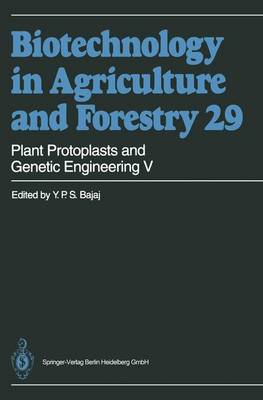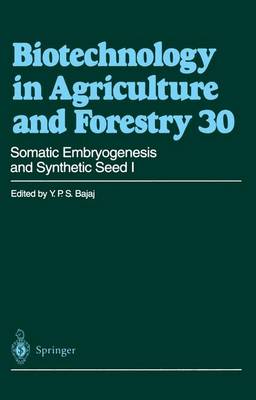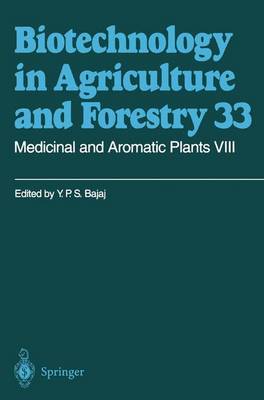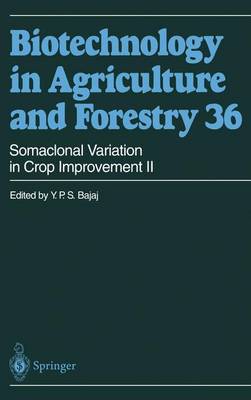Biotechnology in Agriculture and Forestry
23 primary works • 25 total works
Book 29
Plant Protoplasts and Genetic Engineering V
by Professor Dr. Y. P. S. Bajaj
Published 25 November 1994
In continuation of Volumes 8, 9, 22, and 23, this new volume deals with the regeneration of plants from isolated protoplasts and genetic transformation in various species of Actinidia, Allocasuarina, Anthurium, Antirrhinum, Asparagus, Beta, Brassica, Carica, Casuarina, Cyphomandra, Eucalyptus, Ipomoea, Larix, Limonium, Liriodendron, Malus, Musa, Physcomitrella, Physalis, Picea, Rosa, Tagetes, Triticum, and Ulmus. These studies reflect the far-reaching implications of protoplast technology in genetic engineering of plants. The book contains a wealth of useful information for advanced students, teachers, and researchers in the field of plant tissue culture, molecular biology, genetic engineering, plant breeding, and general biotechnology.
Book 30
While working in the laboratory of Professor Dr. Jacob Reinert at the Freie Universitat Berlin (1974-1976), I had the opportunity to become deeply involved in studying the intricacies of the fascinating phenomenon of somatic embryogenesis in plant cells and protoplasts. In numerous stimu lating discussions with Professor Reinert on this subject, I was fully convinced that somatic embryogenesis would become one of the most important areas of study, not only regarding basic and fundamental aspects, but also for its application in crop improvement. During the last decade, we have witnessed tremendous interest and achievements in the use of somatic embryos for the production of synthetic seeds, for micro propagation, genetic transformation, cryopreservation, and conservation of germplasm. The en masse production of somatic embryos in the bioreactors has facilitated some of these studies. Somatic embryos have now been induced in more than 300 plant species belonging to a wide range offamilies. It was therefore felt that a compilation ofliterature/state of the art on this subject was necessary. Thus, two volumes on Somatic Embryo genesis and Synthetic Seed have been compiled, which contain 65 chapters contributed by International experts. Somatic Embryogenesis and Synthetic Seed I comprises 31 chapters, arranged in 3 sections: Section I Commitment of the cell to somatic embryogenesis; early events; anatomy; molecular basis; gene expression; role of polyamines; machine vision analysis of somatic embryos. Section II Applications of somatic embryos; technology of synthetic seed; fluid drilling; micropropagation; genetic transfor mation through somatic embryos; cryopreservation.
Book 33
This series ofbooks on the biotechnology of Medicinal and Aromatic Plants provides a survey of the literature focusing on recent information and the state of the art in tissue culture and the in vitro production of secondary metabolites. This book, Medicinal and Aromatic Plants VIII, like the previous seven volumes published in 1988, 1989, 1991, 1993, and 1994, is unique in its approach. It comprises 26 chapters dealing with the distribution, importance, conventional propagation, micropropagation, tissue culture studies and the in vitro production of important medicinal and pharmaceutical compounds in various species of Achillea, Anethum, Aquilaria, Arnica, Aspergillus, Astragalus, Catalpa, Chelidonium, Eremo- phila, Eucalyptus, Eucommia, Geranium, Heterocentron, Hypericum, Maclura, Morinda, Mortierella, Nicotiana, Phaseolus, Pinellia, Piqueria, Psorales, Rhodiola, Sanguisorba, Valeriana, and Vancouveria. This book is tailored to the needs of advanced students, teachers, and research scientists in the field of pharmacy, plant tissue culture, phytochemistry, biochemical engineering, and plant biotechnology in general. New Delhi, July 1995 Professor Y. P. S.
BAJAJ Series Editor Contents I Achillea millefolium L. ssp. millefolium (Yarrow): In Vitro Culture and Production of Essential Oils A. C. FIGUEIREDO, M. S. S. PAIS, and J. J. c. SCHEFFER (With 9 Figures) 1 Introduction...1 2 In Vitro Culture Studies ...4 3 Ultrastructural Study of the Glandular Trichomes and Cell Suspension Cultures ...8 4 Composition of the Essential Oils of A. millefolium In Vivo and In Vitro ...11 5 Summary and Conc1usion ...15 6 Protocol ...15 References ...17 II Anethum graveolens L.
BAJAJ Series Editor Contents I Achillea millefolium L. ssp. millefolium (Yarrow): In Vitro Culture and Production of Essential Oils A. C. FIGUEIREDO, M. S. S. PAIS, and J. J. c. SCHEFFER (With 9 Figures) 1 Introduction...1 2 In Vitro Culture Studies ...4 3 Ultrastructural Study of the Glandular Trichomes and Cell Suspension Cultures ...8 4 Composition of the Essential Oils of A. millefolium In Vivo and In Vitro ...11 5 Summary and Conc1usion ...15 6 Protocol ...15 References ...17 II Anethum graveolens L.
v. 36
In continuation of Somaclonal Variation and Crop Improvement I (1990), this volume is comprised of twenty-four chapters dealing with somaclonal variants showing resistance to salt drought, herbicides, viruses, Alternaria, Fusarium, Glomerella, Verticillium, Phytophthora, fall armyworm, etc. in a number of plants of economic importance. It is divided into two sections: Section I. Somaclonal Variation in Agricultural Crops: wheat, rice, maize, sorghum, potato, tomato, Lotus, Stylosanthes, banana, strawberry, citrus, colt cherry. Section II. Somaclonal Variation in Medicinal and Aromatic Plants: Atropa, Carthamus, Hypericum, Lavatera, Nicotiana, Primula, Rauwolfia, scilla, and Zinnia.
v. 17
Second in the series, High-Tech and Micropropagation, this work covers the micropropagation of trees and fruit-bearing plants, such as poplar, birches, larch, American sweetgum, black locust, Sorbus, sandalwood, Quercus, cedar, Persian walnut, date palm, cocoa, Citrus, olive, apple, pear, peach, plum, cherry, papaya, pineapple, kiwi, Japanese persimmon, grapevine, strawberry, and raspberry. The importance and distribution of conventional propagation and in vitro studies on individual species are discussed. In particular detail, the transfer of in vitro plants to the greenhouse or the field, and the prospects of commercial exploitation are examined. The book will be of use to advanced students, research workers and teachers in horticulture, forestry and plant biotechnology in general, and also to individuals interested in industrial micropropagation.




